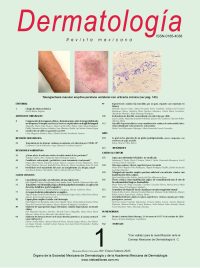Laura Castilla,2 Alejandra Jaramillo Arboleda,2 Juliana Silva Gutiérrez,1 Mariam Rolón,4 Adriana Motta4
1 Médica general, Universidad de La Sabana, Chía, Colombia.
2 Residente de Dermatología.
3 Dermatopatóloga.
4 Dermatóloga, Hospital Simón Bolívar.
Universidad El Bosque, Bogotá, Colombia.
Resumen
ANTECEDENTES: El escleredema de Buschke es una enfermedad del tejido conectivo, caracterizada por engrosamiento de la dermis con depósito de mucina entre las fibras de colágeno, que se manifiesta como un endurecimiento de la piel que, cuando afecta el rostro, genera falta de expresión y dificultad para abrir la boca. Puede ser concomitante con la diabetes mellitus, infecciones respiratorias y gammapatías monoclonales.
CASO CLÍNICO: Paciente masculino en la quinta década de la vida, sin antecedentes médicos de importancia quien, después de un cuadro respiratorio de las vías aéreas superiores, manifestó sensación de piel rígida y tirante, principalmente en el tercio superior del tronco que limitaba la rotación cervical y la apertura oral. El estudio histopatológico evidenció un ligero engrosamiento de las bandas de colágeno de todo el espesor dérmico, desplazamiento de los anexos y leve craquelamiento intersticial atribuible a esclerodermia. El perfil de serología evidenció prueba rápida para VIH negativa, virus hepatotropos negativos y prueba no treponémica positiva en 64 diluciones, sugerente de infección por sífilis.
CONCLUSIONES: En el caso comunicado coexistía una enfermedad autoinmunitaria con una infección multisistémica. La simultaneidad de estos trastornos es poco frecuente; ésta es la primera descripción en la bibliografía. Su diagnóstico incluye la historia clínica, la exploración física, los hallazgos histopatológicos y estudios paraclínicos. Ambas enfermedades repercuten en la calidad de vida de los pacientes, por lo que su diagnóstico y tratamiento correctos son fundamentales.
PALABRAS CLAVE: Escleredema de Bushcke; enfermedad del tejido conectivo; sífilis; enfermedades autoinmunitarias.
Abstract
BACKGROUND: Scleredema of Buschke is a connective tissue disease characterized by dermis thickening with mucin deposits among the collagen fibers that clinically it presents as a hardening of the skin that, when it affects the face, causes a lack of expression and difficulty in opening the mouth. It may coexist with diabetes mellitus, respiratory infections and monoclonal gammopathies.
CLINICAL CASE: A male patient in the fifth decade of life, with no significant medical history who, after a respiratory episode of the upper airway, presented a sensation of rigid and tight skin, mainly at the upper third of the trunk, which limited cervical rotation and oral opening. The histopathological study revealed a slight thickening of the collagen bands throughout the dermal thickness, displacement of the skin appendages and discrete interstitial cracking attributable to scleroderma, and the serology profile showed a negative rapid test for HIV, negative hepatotropic viruses, and a positive non-treponemal test at 64 dilutions, suggestive of syphilis infection.
CONCLUSIONS: This clinical case had an autoimmune disease concomitant with a multisystemic infection. The simultaneity of these disorders is rare, being the first description in the literature. The diagnosis includes: clinical history, physical examination, histopathological findings and paraclinical studies. Both diseases affect quality of patients’ lives, therefore, correct diagnosis and treatment are essential.
KEYWORDS: Scleredema adultorum; Connective tissue disease; Syphilis; Autoimmune diseases.
Recibido: abril 2023
Aceptado: junio 2023
Este artículo debe citarse como: Castilla L, Jaramillo-Arboleda A, Silva-Gutiérrez J, Rolón M, Motta A. Escleredema de Buschke concomitante con infección por sífilis. Dermatol Rev Mex 2025; 69 (1): 105-111.

